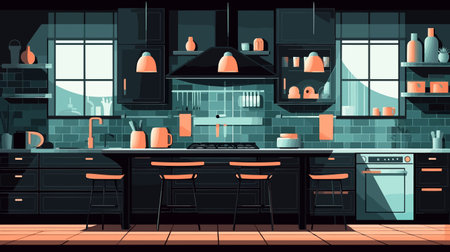The Evolution of the American Kitchen
Once tucked away behind closed doors, kitchens in American homes were traditionally functional and isolated. Their primary purpose was to prepare meals, hidden from guests and daily living spaces. Over time, cultural shifts and changes in family dynamics sparked a transformation. The kitchen slowly emerged from its secluded corner, evolving into an open, inviting area that blends seamlessly with living and dining zones. This shift mirrored a growing desire for connection—a space where cooking, socializing, and everyday life intersect. Today’s open concept kitchens reflect this evolution, serving not just as a place to cook, but as the heart of the home where everyone comes together.
2. What Makes an Open Concept Kitchen
The open concept kitchen isn’t just a fleeting trend—it’s a lifestyle statement rooted in modern American design. At its core, this layout breaks down the barriers of traditional kitchens, merging cooking, dining, and living spaces into one seamless environment. Here’s what defines an open concept kitchen and why it continues to resonate with homeowners:
Key Features of Open Concept Kitchens
| Feature | Description |
|---|---|
| Spacious Floor Plans | Large, unobstructed areas allow for free movement and flexibility in layout. |
| Minimal Walls | Walls are kept to a minimum, often only where structurally necessary, creating sightlines that connect multiple spaces. |
| Intuitive Flow | The kitchen seamlessly transitions into dining and living zones, encouraging interaction and togetherness. |
Why These Elements Matter
An open concept kitchen aligns with the American emphasis on social connection and casual entertaining. Without walls dividing each area, hosts can cook while chatting with guests or keeping an eye on kids at play. The spaciousness also allows for multifunctional uses—think homework at the island or cocktail hour around the counter. It’s about making life easier and more beautiful through smart, intentional design.

3. Social Connection at the Heart
Open concept kitchens have become more than just a design trend—they embody the essence of American hospitality and togetherness. By removing physical barriers, these kitchens create a seamless flow between cooking, dining, and living spaces. This layout transforms the kitchen into a social hub, where family and friends naturally gather and connect. Whether it’s hosting a casual brunch or an evening dinner party, open kitchens make everyone feel included in the experience. The cook is no longer isolated; instead, conversation flows freely across the room. In many American homes, this openness encourages spontaneous gatherings, shared meals, and genuine moments of connection—capturing the spirit of entertaining that’s so integral to modern living.
4. Light, Space, and Style
Open concept kitchens are celebrated for their transformative design benefits. By removing barriers, these spaces invite abundant natural light to flow freely from windows and skylights throughout the main living areas. The result is a brighter, more uplifting environment that enhances everyday life. In American homes where entertaining and daily routines blend seamlessly, maximizing both natural light and perceived space is essential.
Design Benefits at a Glance
| Benefit | Description |
|---|---|
| Natural Light | Open layouts allow sunlight to penetrate deeper, reducing the need for artificial lighting during the day. |
| Perceived Space | The absence of walls visually expands the kitchen, making even modest homes feel airy and expansive. |
| Modern Aesthetics | Sleek lines, uncluttered surfaces, and minimal decor fit perfectly with contemporary tastes. |
Minimalism Meets Functionality
American homeowners value designs that balance beauty with practicality. Open concept kitchens support a minimalist approach—think clean countertops, integrated appliances, and streamlined cabinetry. This not only keeps visual clutter at bay but also makes daily cleaning and organizing easier.
Why It Works in American Homes
The open kitchen supports flexible lifestyles. Whether it’s hosting a dinner party or supervising homework at the island while cooking, this layout brings families and friends together. In essence, open concept kitchens reflect the American desire for spaces that are bright, spacious, and effortlessly stylish.
5. Functionality Meets Flexibility
Open concept kitchens are more than just a design statement—they’re built for the way we live now. In today’s fast-paced world, multitasking is second nature. With an open kitchen, you can prep dinner while keeping an eye on your kids’ homework or chatting with guests at the island. The seamless flow between kitchen, dining, and living spaces makes it easy to manage multiple activities at once, all without missing a beat.
As remote work becomes the norm across America, families need adaptable environments. Open kitchens naturally accommodate work-from-home setups. The extended countertop or breakfast bar quickly transforms into a workspace—think laptops open next to your morning coffee, or Zoom calls happening in the heart of your home. No more feeling isolated; you can be productive while staying connected to household life.
Evolving family dynamics also play a huge role in the popularity of open concept kitchens. Today’s households are multigenerational and diverse, often requiring spaces that flex throughout the day. Whether it’s kids doing school projects, teens hanging out with friends, or grandparents joining in meal prep, open kitchens make everyone feel included. It’s about creating a fluid environment where boundaries are blurred but connections are strengthened—a modern solution for modern living.
6. Challenges and Trade-offs
While open concept kitchens exude a sense of effortless style and connection, they come with their own set of challenges. Noise is often the first consideration—without walls to buffer sound, everything from clanging pans to lively conversations travels easily throughout the space. For families or those who love to entertain, this can be both a perk and a pitfall.
Privacy is another factor. The seamless flow means that kitchen activities are always on display. If you cherish moments of solitude or want to hide culinary chaos during gatherings, the open plan may require creative solutions.
Clutter visibility is perhaps the most practical concern. In an open kitchen, there’s no closing the door on messy countertops or stacks of dishes. This design demands a commitment to daily tidying and smart storage solutions.
Balancing Form and Function
To master the open concept, consider integrating subtle zoning techniques. Rugs, lighting, and furniture placement can visually separate areas without sacrificing flow. Invest in quiet appliances, and incorporate plenty of closed cabinetry to minimize visual clutter. For added privacy or noise control, flexible options like sliding panels or glass partitions offer separation when needed while maintaining light and openness.
Design with Intention
An open kitchen thrives on thoughtful curation—choose materials that are easy to clean, keep décor minimal yet inviting, and let functional beauty drive your choices. By acknowledging these trade-offs and addressing them head-on, you can enjoy all the benefits of this enduring trend without compromising on comfort or style.
7. Enduring Popularity and Future Outlook
Open concept kitchens have stood the test of time in American homes, evolving from a fleeting trend to a fundamental design philosophy. Their enduring popularity is rooted in their ability to foster togetherness, create a sense of spaciousness, and adapt to the ever-changing rhythms of daily life. As family dynamics, work-from-home routines, and entertaining styles continue to shift, open concept kitchens offer unmatched flexibility. Looking ahead, we can expect these spaces to further integrate smart technology, sustainable materials, and personalized zones that cater to diverse lifestyles. The open kitchen will remain a staple because it’s more than just a layout—it’s an invitation for connection, creativity, and comfort at the heart of the home.


